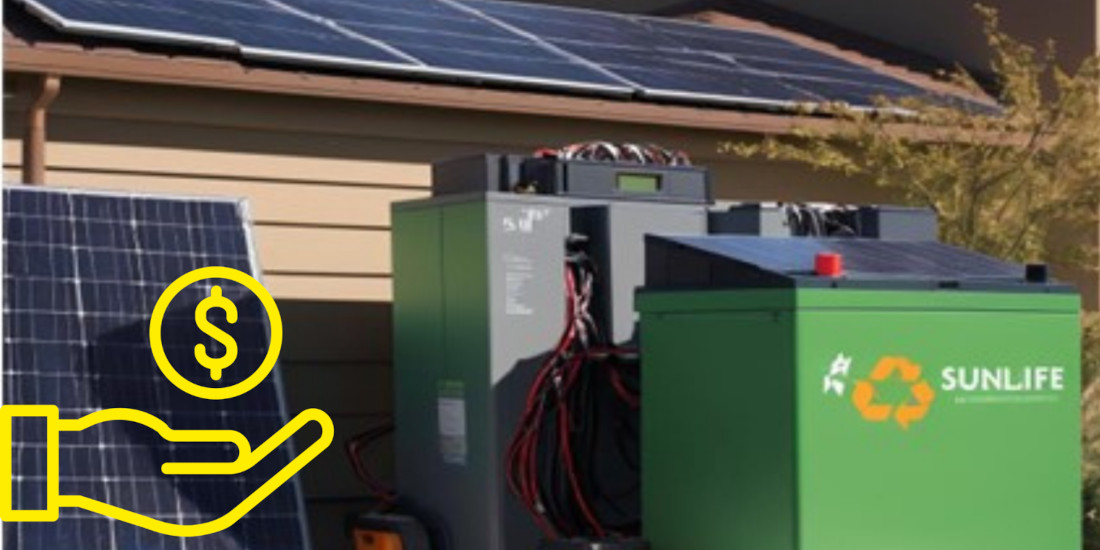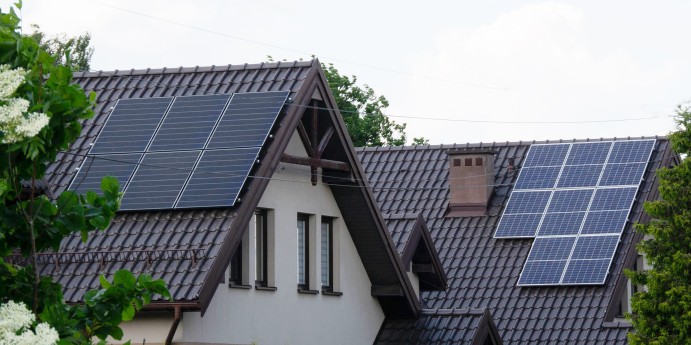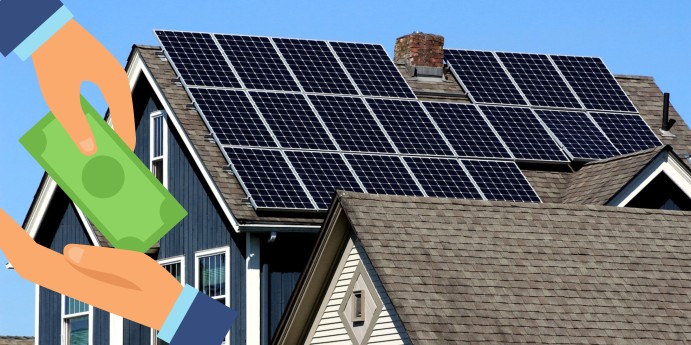Sunshine on your roof and freedom from the huge electricity bills – that’s the dream, right? Solar panels capture sunlight, but what about after sunset? That’s where solar storage comes in!
Solar storage acts as a giant battery, storing daytime sunshine for nighttime, cloudy days, or winter use! However, understanding the costs of various storage options can be challenging. This guide will explain the prices of common solar storage options, with a focus on the current situation in New York and New Jersey.
We know that Solar Panels only produce electricity when the sun is shining, in contrast to conventional power plants that run nonstop. This implies that, particularly in cities like New York and New Jersey, during the shorter winter days, you may have too much power during the day and insufficient at night. But when your solar panels generate excess energy during the hours of maximum sunlight, solar storage acts as a massive battery, storing it for later use. Thus, you may continue to use clean, dependable solar electricity to run your appliances and lights even after the sun sets.
For those new to solar electricity, the initial cost of solar storage may seem high. Before we get into the statistics, though, keep in mind that the initial outlay may result in considerable long-term electricity cost reductions. You may become more energy independent and less vulnerable to changes in energy prices by depending less on the conventional power system. This can be a huge advantage, especially in cities like, New York and New Jersey, where we’re all aware with those erratic energy prices.
Now, let’s explore the different battery technologies commonly used for solar storage, understanding their costs and functionalities.
1. Lithium-ion (Li-ion) Batteries: The Powerhouse Choice
Think of lithium-ion batteries as the workhorses of the solar storage world. They offer high efficiency, meaning minimal energy loss during storage and retrieval. They also boast a relatively long lifespan compared to other options, typically lasting 10 to 15 years. However, there’s a trade-off – lithium-ion batteries generally come with a higher upfront cost per kilowatt-hour (kWh).
The National Renewable Energy Laboratory (NREL) reports that lithium-ion batteries cost between $1,000 and $3,000 per kWh (https://atb.nrel.gov/electricity/2022/utility-scale_battery_storage). While they might be pricier per unit, their widespread availability, excellent performance, and long lifespan make them a compelling choice for many New York and New Jersey residents looking to maximize their solar investment.
Use Cases for Lithium-ion Batteries:
Home Owners:
Because of their longevity and efficiency, lithium-ion batteries provide a flexible alternative. They are ideal for homeowners who wish to minimise their dependency on the grid or power their homes during power cut.
Commercial Businesses:
Companies can use solar electricity that has been stored to offset their daytime energy demand or guarantee uninterrupted operations during peak hours.
Utility-Scale Initiatives:
Large-scale lithium-ion battery installations can contribute to grid stabilisation and the integration of more renewable energy sources.
2. Batteries with Lead Acid: The Option That Saves Money
Searching for a more affordable way to begin using solar power? Lead-acid batteries could provide the solution. They are a well-known technology that are frequently seen in automobile batteries and provide a less expensive option than their lithium-ion cousins. But be mindful of the constraints. In comparison to lithium-ion batteries, lead-acid batteries usually have a shorter lifespan (3-5 years) and lesser efficiency. This implies that they might require more regular replacements, which could offset part of the initial cost savings.
According to Energy Sage, a website dedicated to solar energy education, lead-acid batteries cost between $300 and $800 per kWh (https://www.energysage.com/solar-batteries/). Despite the lower upfront cost, think about the long-term implications. The frequent replacements and lower efficiency could lead to higher overall expenses compared to lithium-ion batteries.
Use Cases for Lead-Acid Batteries:
Off-Grid Solar Systems:
Lead-acid batteries can be a good option for houses and businesses that aren’t connected to the regular electricity grid (power lines) for their basic storage needs. However, because they don’t last as long, they might not be the best choice for places that need a lot of power and aren’t connected to the grid.
Smaller-Scale Applications
: Lead-acid batteries might be a reasonably priced choice for smaller solar arrangements, such as powering a garden shed or a backup system for necessary appliances.
3. Flow Batteries:
A more recent innovation with great potential for solar energy storage are the Emerging Contender flow batteries.
Flow batteries use liquid electrolytes to capture and release energy, unlike lithium-ion or lead-acid batteries, which store energy chemically. This has a few clear benefits.
- Like lithium-ion batteries, flow batteries have a long lifespan (15–20 years) and are renowned for their great efficiency.
- The recyclability of electrolytes makes them environmentally friendly. However, flow batteries are currently more expensive up front than lead-acid batteries, and because of their more intricate design, they could need special installation.
The Rocky Mountain Institute reports that flow batteries cost between $500 and $1,500 per kWh (https://rmi.org/insight/economics-battery-energy-storage/). While the cost might be higher upfront, the long lifespan and potential environmental benefits make them an attractive option for long-term energy storage needs.
Use Cases for Flow Batteries:
• Utility-Scale Solar Projects:
Due to their huge capacity and extended lifespan, flow batteries are a good fit for grid-scale energy storage applications and large-scale solar farms.
• Industrial Applications:
Flow batteries’ dependable storage qualities are advantageous for establishments with high and steady energy requirements.
When selecting solar storage, pricing is an important consideration, but it’s not the only one. Here are a few more things to remember:
System Size
: As total system capacity rises, solar storage costs per kWh typically fall. Because of economies of scale, larger installations have lower average costs per kWh.
Rebates and Incentives:
The United States government offers rebates and other incentives to encourage homeowners in cities like New Jersey and New York to use solar energy storage. These programs reduce solar installation costs, increasing accessibility to solar power. Research the current Government initiatives in your area. The New Jersey Board of Public Utilities (NJBPU) (https://www.nj.gov/bpu/ ) and the New York State Energy Research and Development Authority (NYSERDA) (https://www.nyserda.ny.gov/ ) are the places to get information on programs in New Jersey and New York, respectively.
Remember, the best choice for you depends on your specific needs and budget. Understanding the cost considerations, advantages, and disadvantages of each solar storage technology is crucial. It allows you to make an informed decision. This decision maximizes the return on your investment in clean, reliable solar energy.
Q: Are there any government rebates available in New Jersey and New York to assist with the cost of solar storage?
Ans: Of course! Rebates and other incentives are provided by both states to entice residents to install solar storage systems. These may lower the starting price. But the programs may change on time to time basis, so please refer the following information-
- New Jersey: The New Jersey Board of Public Utilities (NJBPU) is the primary source for information on solar incentives in the state. They offer various programs, including rebates, tax credits, and grants. You can find the latest details on their website: https://www.nj.gov/bpu/
- New York: The New York State Energy Research and Development Authority (NYSERDA) manages solar programs for homeowners in the state. They offer rebates, financing options, and tax breaks. You can find the latest information on their website: https://www.nyserda.ny.gov/All-Programs/Clean-Energy-Siting-Resources/Solar-Guidebook
Q: How can I choose the best solar storage system for my house or place of business?
Ans: Consider your budget, the amount of room you have, how much energy you consume on average, and your long-term objectives. Speaking with a certified solar installer might also help you make some wise decisions. Please Contact SunLife Solar, an dynamic and experienced Solar Power Installation service provider, today at +18334786669 or visit our website https://sunlifenow.com/ to schedule your FREE consultation with the Solar Power experts. Please ensure that you have the quality products and services you need, backed by 25 years of warranty, for a long-term, reliable solar energy solution.
Q: What is the expected lifespan of a solar storage battery?
Ans: The type of battery and how it is used will determine this. Lead-acid batteries may need to be replaced every three to five years, whereas lithium-ion batteries often last ten to fifteen years.
Q: Do I need a professional to install the solar storage, or can I do it myself?
Ans: It is generally advisable to employ a professional installation service provider, who is equipped with experienced and knowledgeable experts, who first does the inspection of the site and proceed accordingly, based on different criteria. Even if you may be able to install some systems yourself, the Solar Power Experts can guarantee that the system fits your demands precisely, and functions flawlessly, offering high quality and sustainable Solar Power equipment, like Solar Panel, Batteries, etc., with a warranty of at least 25 years.
 833-478-6669
833-478-6669



